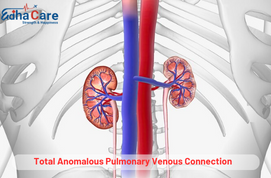Total Anomalous Pulmonary Venous Connection

The congenital heart condition known as total anomalous pulmonary venous connection (TAPVC) happens when pulmonary veins, which are meant to convey oxygen-rich blood from the lung area to the left ventricles of the heart, fail to form an appropriate connection with the chambers of the heart. Rather, they either abut the right atrium directly or join aberrantly to other blood vessels. This reduces the effectiveness of providing oxygen to the human organism by causing blood with high levels of oxygen to mingle with blood that is deoxygenated. depending on how severe the abnormality is, there may be a variety of signs, including fast breathing, poor feeding, cyanosis (bluish staining of the skin), and failure to thrive. To fix the faulty connections and return to normal blood flow, TAPVC requires surgery.
About Total Anomalous Pulmonary Venous Connection
Total Anomalous Pulmonary Venous Connection Symptoms : A variety of signs are evident with total anomalous pulmonary venous connection (TAPVC), which primarily affects newborns shortly after delivery. A telltale indication of cyanosis is the bluish coloring of the skin caused by low oxygen in the blood levels. Affected newborns may also have low weight gain, exhaustion, difficulty eating, and difficulty breathing. Labored breath or additional signs of difficulty breathing could possibly be markers of respiratory distress. Certain newborns may exhibit cardiac symptoms, such as tachycardia, a rapid heart rate, or edema in their legs and belly, which is suggestive of heart failure. Early recognition of these signs is crucial for improving the prognosis of TAPVC patients since it facilitates immediate medical treatment.
Total Anomalous Pulmonary Venous Connection Causes : A congenital cardiac condition known as total anomalous pulmonary venous connection (TAPVC) occurs when pulmonary veins fail to correctly join the heart during fetal development. Although the precise reason is yet unresolved anomalies in the growth of the embryonic heart are thought to be involved. Given that certain genetic mutations or chromosomal defects have been linked to congenital heart problems, genetic factors most likely play a role in TAPVC risk can be increased as well by environmental variables that are present during pregnancy, such as exposure to chemicals or diseases in the mother. TAPVC, however, frequently manifests as random events without a clear underpinning genetic or environmental etiology. It is believed that a combination of environmental factors and genetic predisposition during embryonic growth causes the disorder.
Total Anomalous Pulmonary Venous Connection Remedies : The primary therapy for complete anomalous pulmonary venous connection (TAPVC) is an operation to fix the pulmonary vein' aberrant connection. The normal flow of blood has been restored when pulmonary veins are surgically redirected to correctly link to the left atrial of the heart. The purpose of this corrective procedure is to increase oxygenation in the blood and avoid consequences like respiratory distress and heart failure. For those with TAPVC, early identification and timely surgical repair are essential to optimize outcomes. Continuous cardiologist monitoring is usually advised after surgery to evaluate heart function and guarantee long-term viability. For people with TAPVC, surgical treatment provides the best opportunity to improve their quality of life and their long-term prospects.
Procedure of Total Anomalous Pulmonary Venous Connection
Preoperative Evaluation: To evaluate the structure and function of the heart's chambers and its surrounding structures, the patient undergoes an extensive evaluation that includes a review of their medical records, a physical exam, and diagnostic procedures including catheterization of the heart and cardiac echocardiography,
Anesthesia: To maintain the patient unconscious and free of pain during the surgery, general anesthesia is provided.
Incision: To access the heart, a middle sternotomy incision is performed in the chest. As an alternative, in some circumstances, a mini-thoracotomy technique could be performed.
Cardiopulmonary Bypass (CPB): During the procedure, the patient is hooked up to a device called a heart-lung bypass that acts as a temporary replacement for the lungs and heart. This reroutes oxygen and blood through the bypass machine, enabling the surgeon to perform surgery on the beating heart while it is motionless.
Arterial Switch: The pulmonary artery and aorta are carefully repositioned to their proper placements after being disconnected from their aberrant positions by the surgeon. To guarantee that the heart muscle receives the right amount of blood, the coronary arteries are also severed and reattached.
Closure: Following the arterial switch procedure, the incision is closed with sutures or staples after the heart is thoroughly examined for leaks or bleeding.
Postoperative Care: the patient is moved to an intensive care unit (ICU) for careful observation and recuperation. They might need to be on mechanical ventilator, take heart-supporting medication, and get pain relief. Appointments for follow-up are planned in order to evaluate recuperation and keep an eye out for any issues.
Require Assistance?
Get A Quick Callback From Our Healthcare Experts






